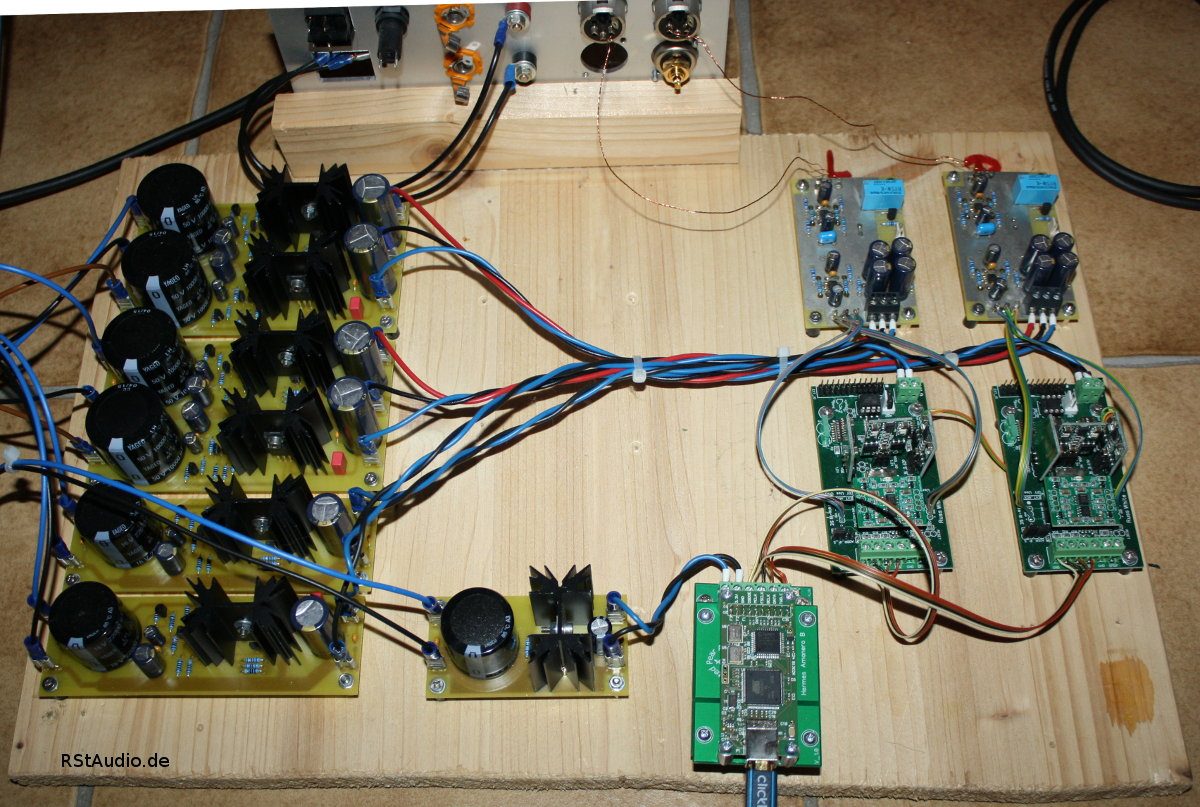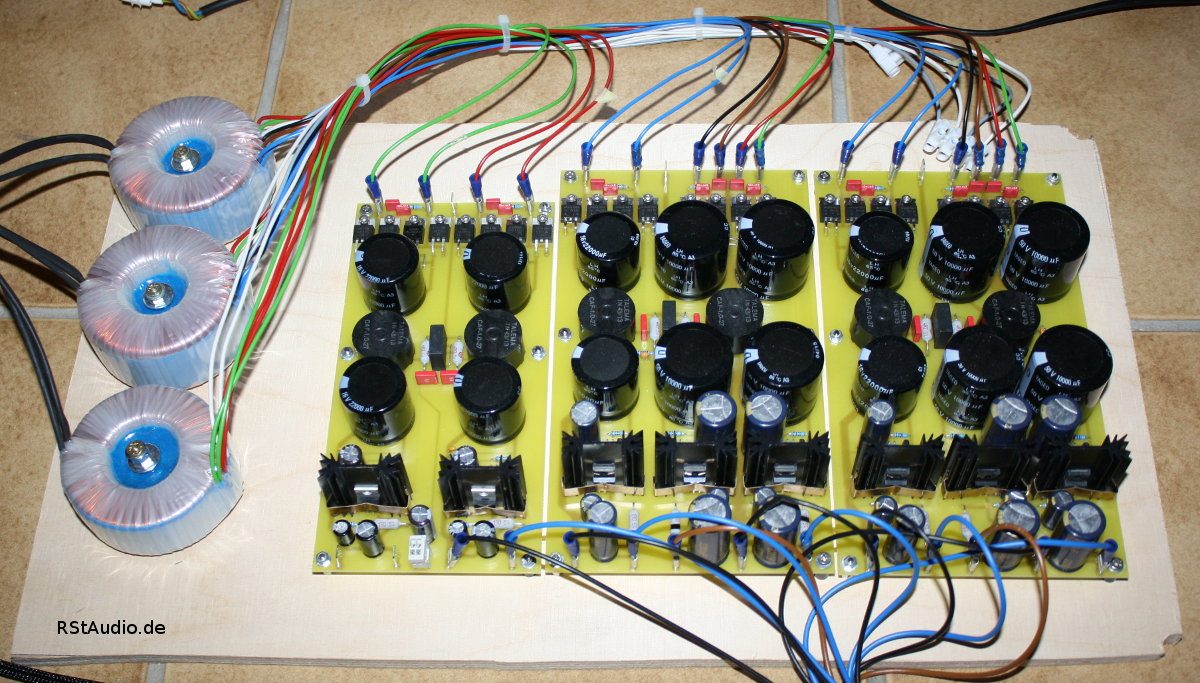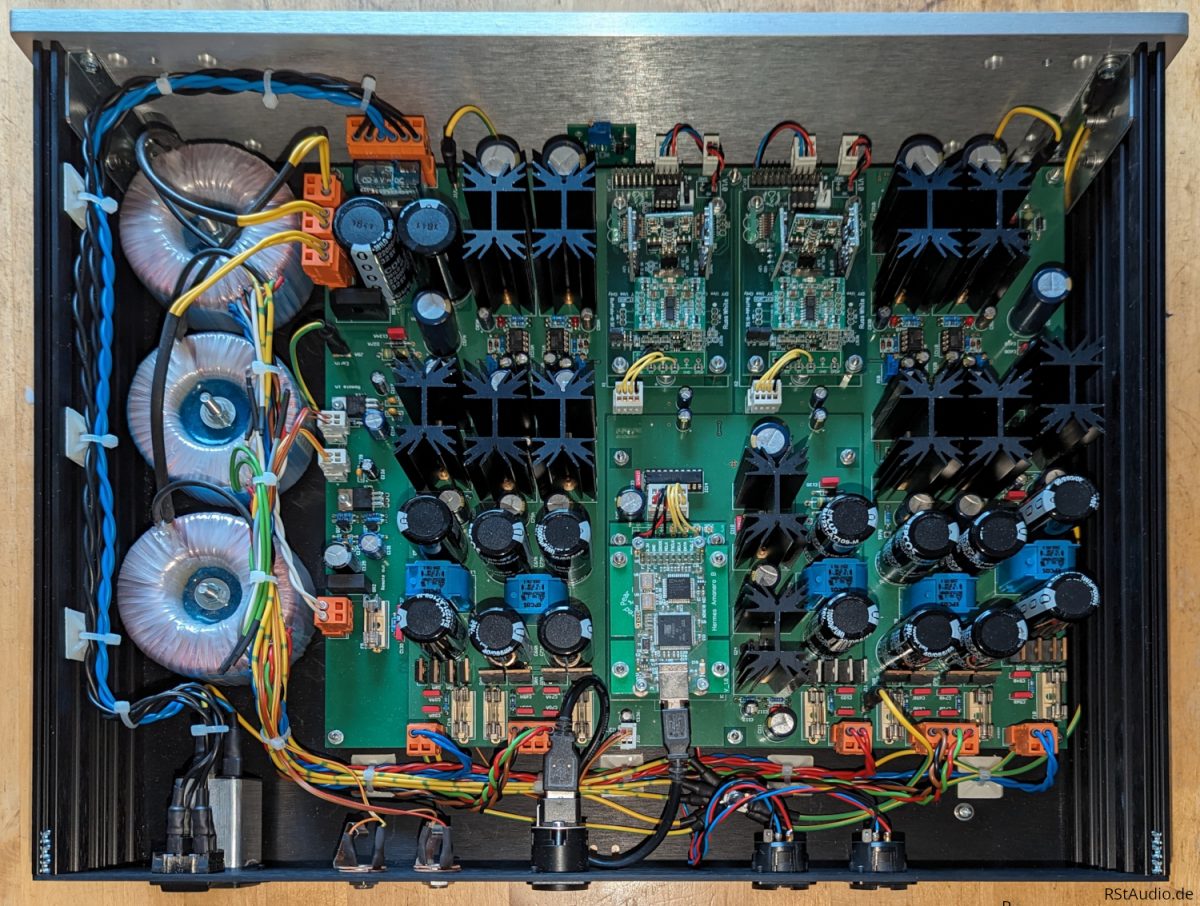
Table of Contents
Introduction
2016-08-10
The idea of building a DAC has been on my mind for many years. In the meantime, I have created at least 4 designs, all based around Burr Brown / Texas Instruments converters, but unfortunately I did not realize them in the end. In mid-2015, I started a new attempt.
In contrast to the previous circuits, this time I wanted to use a chip from ESS Technology, the ES9018 – SABRE32 Reference Audio DAC. However, I had to realize that there are no generally accessible publications of the data sheets and that you have to sign a non-disclosure agreement to get these documents.
In the end, the whole procedure was too time-consuming for me and so I looked around for ready-made circuit boards for this chip. I found what I was looking for at Twisted Pear Audio Audio, whose Buffalo-IIISE DAC I used in my DAC as a dual mono version – i.e. 2 boards in total.
The complete DAC consists of 2 modules containing the following circuit parts:
- DAC Signal Modul
- Amanero Technologies USB OEM Combo384 Module
- Twisted Pear Audio Hermes-Amanero USB Isolator Module
- Twisted Pear Audio Cronus Re-Clocking Module with 45.1584MHz / 49.152MHz Rhea pair
- 2× Twisted Pear Audio Buffalo-IIISE DAC
- 2× RStAudio I/V Converter
- 2× RStAudio discrete symmetrical voltage regulators for the I/V stage
- 2× RStAudio discrete voltage regulators for the DAC modules
- 2× RStAudio integrated voltage regulators for the digital front ends
- DAC Power Supply Module
- 230V/AC supply
- 2× unregulated symmetrical power supply for the analog circuit parts
- 2× unregulated power supplies for the DACs
- 2× unregulated power supplies for the digital front ends
- Remote On/Off
The following table lists the data formats and sampling frequencies that the DAC can handle.
| Sample Rates | Format (Output / Input) | |
|---|---|---|
| S/PDIF Input | up to 192kHz | I2S 24Bit |
| Amanero USB | up to 384kHz | I2S 32Bit up to DSD512 |
| Buffalo-IIISE | up to 384kHz | I2S 32Bit, S/PDIF, DSD |
Description of the Hardware
2016-10-13
I will describe the hardware in detail below. I don’t have schematics for some of the purchased circuit parts, for the others I don’t want to publish them. Nevertheless, I hope that some of the information will be of interest to DIYers who are interested in the Twisted Pear Audio DACs.
Amanero USB Interface
While searching for a USB interface for the DAC, I quickly came across the boards from Amanero Technologies. In the meantime, these boards can also be ordered directly from Twisted Pear Audio. Above all, it was important to me that the interface runs asynchronously and can transfer all current HiRes formats. With 384kHz I2S and DSD512, this board is currently very well equipped. I bought the board directly from the manufacturer, so I had to install a different firmware for operation with the Cronus module (see below). The operation of this module with my Windows 7 PC as a player and with the Twisted Pear audio modules as receivers works without any problems.
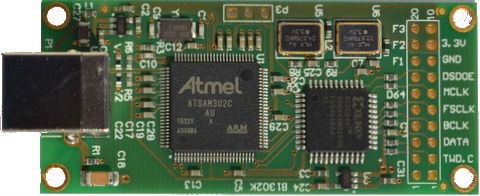
The board is operated in slave mode in conjunction with the Cronus / Hermes boards and so – as already indicated above – a different firmware must be installed. The board has 2 chips that need to be programmed. The CPLD gets the firmware Slave_For_1080 and the CPU gets the firmware firmware_1096c3w2. You can download everything including the drivers for Windows from the manufacturer’s homepage. Here you will also find instructions on how to proceed for programming. You should follow these instructions exactly, then it will also work with the firmware.
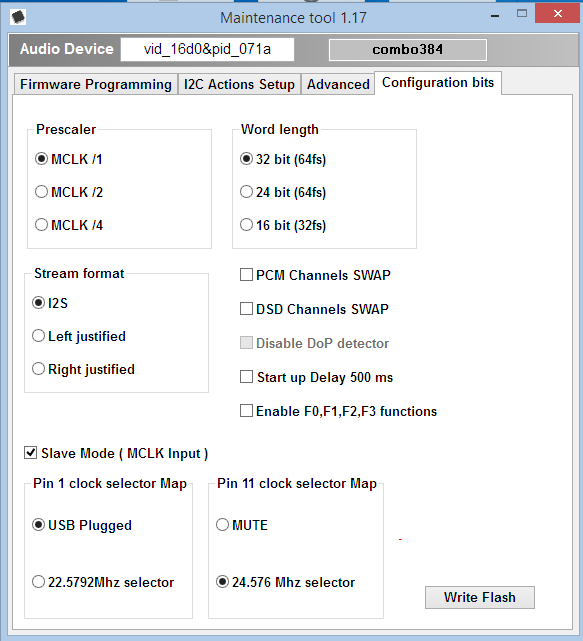
Everything can also be read very nicely in this Thread on diyaudio.com. The screen shot above can also be found there. The configuration bits of the board should be set according to the above information after changing the firmware.
If you order the board directly from Twisted Pear Audio, it is prepared for operation with Cronus and Hermes. So you don’t need to reprogram the firmware.
Hermes-Amanero
This module allows you to use the Amanero Technologies USB module together with the Twisted Pear Audio Cronus module. The USB module is completely isolated and operated in slave mode – it does not generate its own clock, but draws it from the Cronus module. To put it in the words of developer Russ White:
This is not really simply reclocking – it is in fact simply a perfectly time aligned USB source.
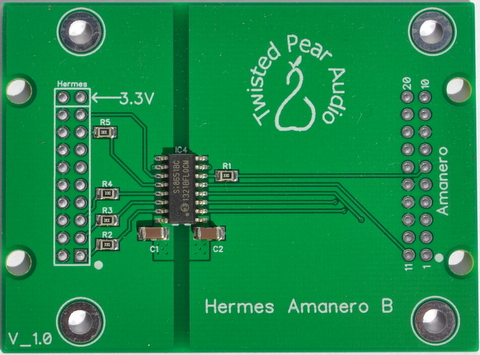
Cronus and Rhea
The Cronus module is an electronic unit that supplies clock signals with very low jitter. It is used to replace the master clock of a player – in this case the USB connection. Two extremely low-noise crystal oscillators are used for this purpose – the Rhea modules. I opted for the modules with the higher frequencies (45.1584MHz and 49.152MHz). They form the basis for the 44.1kHz and 48kHz clock family in digital signal processing.
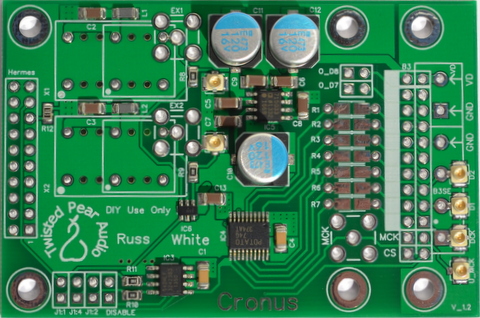
When using the Rhea clocks described above, it is important to set the clock divider in the direction of Amanero to 1:2. This requires a jumper on the Cronus board.
The Hermes board is designed so that all 3 boards can be stacked on top of each other using connector strips. This results in the shortest possible connections, very high operational reliability and a small footprint (see picture below).
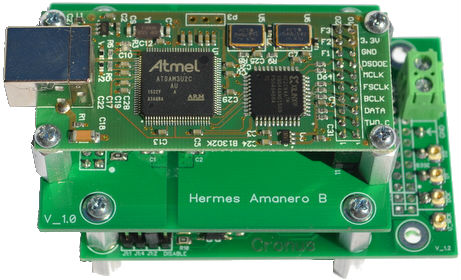
Buffalo-IIISE DAC
As I wrote above, the two boards are based on the ESS Technology ES9018 SABRE32 Reference Audio DAC. This is a chip with a total of 8 D/A converters, 4 of which are connected together on the Buffalo IIISE board. The result is a stereo DAC with improved noise performance. With the dual mono version, which I use, you take 2 boards and connect the two channels together on one board – so you have 8 D/A converters connected in parallel with a further improvement in the signal-to-noise ratio.
Care must be taken when wiring the I/V stage. The two analog outputs of the Buffalo-IIISE are not assigned the same in the mono configuration. However, everything is well described in the instructions
leonvb-buffalo_iii_dac_integration_guide_v2.1.3.pdf
for the boards (on page 44). They can be downloaded from the manufacturer’s website.
I/V Converter
The DACs supply balanced output currents. An I/V stage must be designed in such a way that it optimally converts these signals into voltages and is adapted to the special features of balanced signals. In the implementation described here, I use integrated circuits. The balanced OPA1632 from Texas Instruments is particularly suitable, especially as the audiophile properties of this chip are exceptional.
The entire circuit of a channel consists of two OPA1632s connected in series. The first is connected as a current-to-voltage converter. This stage is followed by a passive symmetrical low-pass filter. As all digital signals in the DACs pass through an oversampling stage and the output signal is correspondingly high frequency, the filter can be designed very simply – in this case it is a first-order filter. The second OPA1632 serves as a voltage amplifier and output driver.
This stage is a first implementation to get a good sounding solution quickly. It is based on the design of the Twisted Pear Audio IVY III Balanced Linestage. I am aiming for a discrete I/V stage as the final solution. The stage described here serves as a reference.
A dimensioning specification for the I/V stage is given in the instructions above. For 8 DACs connected in parallel – as is the case with the mono configuration – a resistance value of 360Ω is recommended for the current-voltage converter. With this dimensioning, the level behind the first OPA1632 is clearly too high and has to be reduced again by the second stage. I didn’t like this at all and so I reduced the two resistors in the first stage to 150Ω and adjusted the gain of the second stage to the output level of my SACD player.
Power Supply
The entire power supply from the DACs onwards is designed as a dual mono configuration – as is always the case in my designs. Naturally, this is not possible with the digital front end.
For the voltage regulators for the I/V stages and the DAC boards, I rely on the tried and tested discrete voltage regulators that I also use in my VV5 – the Pass regulators that I have modified. The control circuits for the I/V stages are symmetrical and those of the DAC boards only have one voltage each. I supply the purely digital circuits with voltage regulators based on the LT3080 from Linear Technology, a truly remarkable and versatile chip.
The unregulated DC power supplies in the Power Supply Module are located upstream of the regulators. A 230V/AC DC filter is located in front of the transformers. Snubber networks are arranged between the secondary windings of the transformers and the rectifiers. The rectifiers are discrete with Ultra Fast Soft Recovery diodes, followed by a CLC filter with relatively large electrolytic capacitors. At the output of all unregulated voltage supplies there are capacitance multipliers – as I said, proven technology, as can also be found in my preamplifier.
The entire voltage supply chain for the I/V stages is designed so that I can provide a voltage of up to ±32V/DC for the analog circuits. To keep the power losses of the regulators within a reasonable range, the transformers are equipped with intermediate taps for the secondary voltages.
Rebuilding 2023
2023-12-28
Unfortunately, the board setup has remained the same since 2016. In addition, I no longer need the DAC on my system since using the Lynx converter. However, I always thought it was a shame to leave the sonically excellent Buffallo-IIISE lying around unfinished.
I have been using a Curryman DAC with a Raspberry Pi 4 on my DHA headphone amplifier for some time now. This circuit is also only built on one board. It made sense to finally clean up this area and put the Twisted Pear DAC in a proper enclosure. It was to replace the Curryman DAC on the DHA. Certainly a step in the right direction in terms of sound.
Since building the board circuit of the ES9018 DAC, however, a lot has changed for me in terms of design. I no longer prefer the discrete Pass voltage regulators I used and now use modified Jung regulators instead. So I developed a new design around the circuit boards from Twisted Pear and Amanero.
However, the aim was to get by with just one enclosure. Given the amount of work I always put into the power supply units, this was quite a challenge. I had also decided to put all the electronics on just one circuit board. There also had to be room in the housing for the 3 toroidal transformers.
To supply the balanced I/V stages with power, I now use a power supply unit with a capacitance multiplier and a modified Jung regulator for each channel. The supply of the Buffalo-IIISE boards consists of a capacitance multiplier followed by a TPS7A4700 voltage regulator. An integrated regulator with exceptional technical data. The digital front end is also supplied by a power supply that first uses a capacitance multiplier, followed by an LT3080 regulator. I had already used such a setup at this point in the board setup above.
Of course, discrete bridge rectifiers with ultra-fast soft recovery diodes are used in all power supply units. There are also snubber networks, as is usual for me. All rectifiers are followed by CLC filtering with a current-compensated double choke.
There are also a few other circuit parts that all had to be included on the board:
- Remote in
- Remote out
- 230V/AC DC-Filter
The central component of the I/V stages is still the excellent symmetrical OPA1632. I use two of them per channel. The first stage is a classic transimpedance amplifier that converts the balanced output currents of the DACs into a corresponding voltage. This is followed by a 2nd order active Bessel filter with a cut-off frequency of 75kHz. Due to the inverting topology of the OPA1632, the filter is realized with a multiple feedback structure. The output is kept offset free with the help of a servo controller. All gain and frequency determining passive components in the stages have been selected by me with a high-quality LCR meter.
Between the two converters and the digital interface, I inserted another component for potential isolation. The 2×3 digital supply lines for the two DACs have exactly the same length. This way I avoid runtime differences.
The photo above shows the inside view of the DAC. On the left-hand side is the circuit board with all the electronic components. On the right side you can see the three toroidal transformers.
The 230V/AC mains connection with socket, filter, fuses and switch is located on the left-hand side of the rear panel. To the right is the input and output for the remote voltages. The DAC’s USB input is located in the middle. On the right side you can see the two analog audio outputs. Balanced in my case, of course. I have omitted the RCA outputs, as I would never use them anyway.
